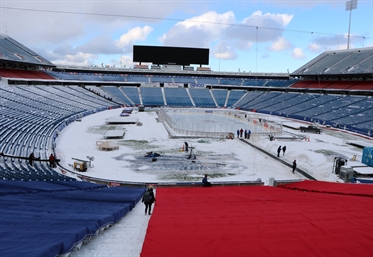On frozen pond
On frozen pond
How USA Hockey took the juniors outdoors

 New Era Field will soon look fuller as the Canada-USA game will be played outdoor today. Photo: Martin Merk
New Era Field will soon look fuller as the Canada-USA game will be played outdoor today. Photo: Martin Merk
The Americans had hosted several previous U20 events, and another in 2018 seemed good timing.
But then USA Hockey started to sift through the bids from various cities hoping to host the tournament, and two cities stood out among the others.
“We had a great opportunity with the cities that submitted bids,” Mike Bertsch, assistant executive director of USA Hockey explained. “We had two entries that included outdoor games in their proposal. We sat down and thought about it, knowing there’s a ton of work involved. We weighed the risks and rewards and thought it was really feasible to have an event like that. They were both NHL teams – Buffalo and St. Louis – so we knew they had the wherewithal to stage an outdoor game. We thought this was an outstanding chance to do something unique with the IIHF.”
And so began a long process to stage the first outdoor game in World Junior Championship history. Buffalo got the nod, primarily because of experience.
“Ironically, we had been talking about an outdoor game at some point,” Bertsch continued, “and the Sabres not only had the idea but they had the existing staff on hand who worked on the Winter Classic in 2008. So with people who had been through the process and knew what it would take to pull it off, and then to market it properly, they had all the elements that we needed to make this happen.”
And it wasn’t just the practical knowledge of installing an outdoor rink on a football field that was important. “The Sabres had budget experience as well and built that into their presentation,” Bertsch continued. “We now understand a lot more about the expenses. It can be profitable if you draw enough people. We have a crowd that will be exceptional, at least 40,000 people, so it will be a good event for USA Hockey and the host organizer.”
No matter what, there was an element of gamble in the decision. You can build it, but will they come? USA Hockey felt they had the answer. “We understood from the 2011 World Juniors that the fan base was here for an outdoor game," Bertsch elaborated. "We were confident we could draw the fans, and we put a lot into marketing. The biggest risk was the weather. We can’t control Mother Nature, but we’ve been fortunate. Things have been working well for us and the forecast is excellent. We’re in good shape.”
No matter how careful the planning, no matter how optimistic, there is always the chance the game might not be a go – poor weather, ice problems, unforeseen circumstances. Bertsch and his group had a contingency plan.
“We knew that we had to make a decision to play or not at least 24 hours in advance of the opening faceoff,” he began. “That would give us the opportunity to come back to Key Bank Center if we couldn’t play outside. We sold about 7,000 packages with the promise that if the game was moved to Key Bank, those fans would be guaranteed seats inside. For the remaining seats, we’d go back and re-sell the tickets in the arena. We were confident that because it was the U.S. and Canada that wouldn’t be a problem. We just had to make the decision in time to let people react. The game would have been at 8pm Friday night.”
Because the rink was the responsibility of the host organizers and had no affiliation with an NHL Winter Classic, planning was up to USA Hockey and the Sabres’ crew.
“The outdoor construction began an hour after the Buffalo Bills finished their game on the 17th,” Berstch explained. “The platforms and trucks came in immediately, and the workers have been working 24/7 ever since.”
Perhaps the only disappointment is that not more is being done with the rink during its brief existence, but there are reasons for that, reasons Bertsch hopes they can overcome next time.
“We went through all the options and couldn’t create the time to do anything more,” he said. “The time we have the ice is limited, so we couldn’t bring in other entities. Because this is an Olympic year, for instance, we considered a sledge hockey game and a women’s game. We’ve had lots of enquiries about youth games. Next time we do this, I’d love to have more days of ice time to incorporate more things like that.”
So, the planning and preparation is done, the bills paid, and the tickets sold, but as Bertsch points out, nothing is set in stone until the game is in the books.
“The most challenging thing in all of this is that you wake up three times in the night checking the weather forecast to figure out what will happen the next day. We’ve been in contact with the local meteorologists with daily updates. That’s the highest part of the anxiety. But everything looks good, and we’re really excited.”
That being said, is it too early to plan anything more in the future? If all goes off without a hitch, would USA Hockey do it again?
“We sure would,” Bertsch said with confidence. “It will be easier to say that tonight if all goes well, but at this point there’s no question we’d do it again. The atmosphere in the building the last two days has been amazing, and that’s without the fans. It’s been phenomenal.”
Fingers crossed, Team Canada and Team USA, USA Hockey and the IIHF will all make a little hockey history this afternoon – so long as the weather continues to cooperate!
Back to Overview

















































